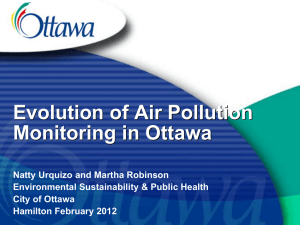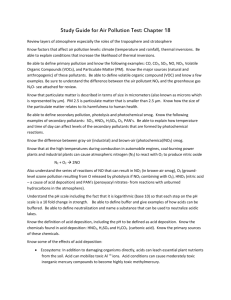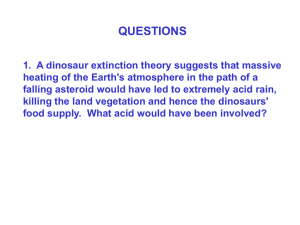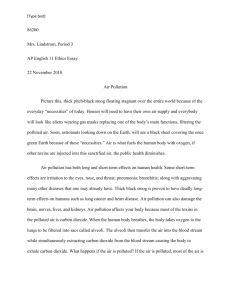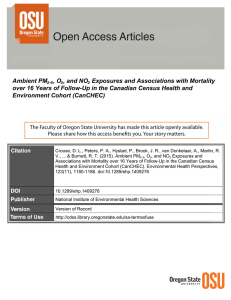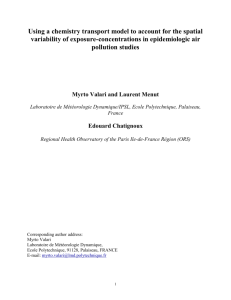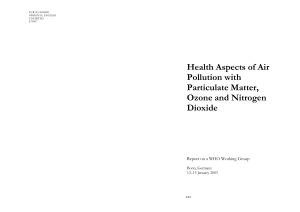EUROPEAN
advertisement
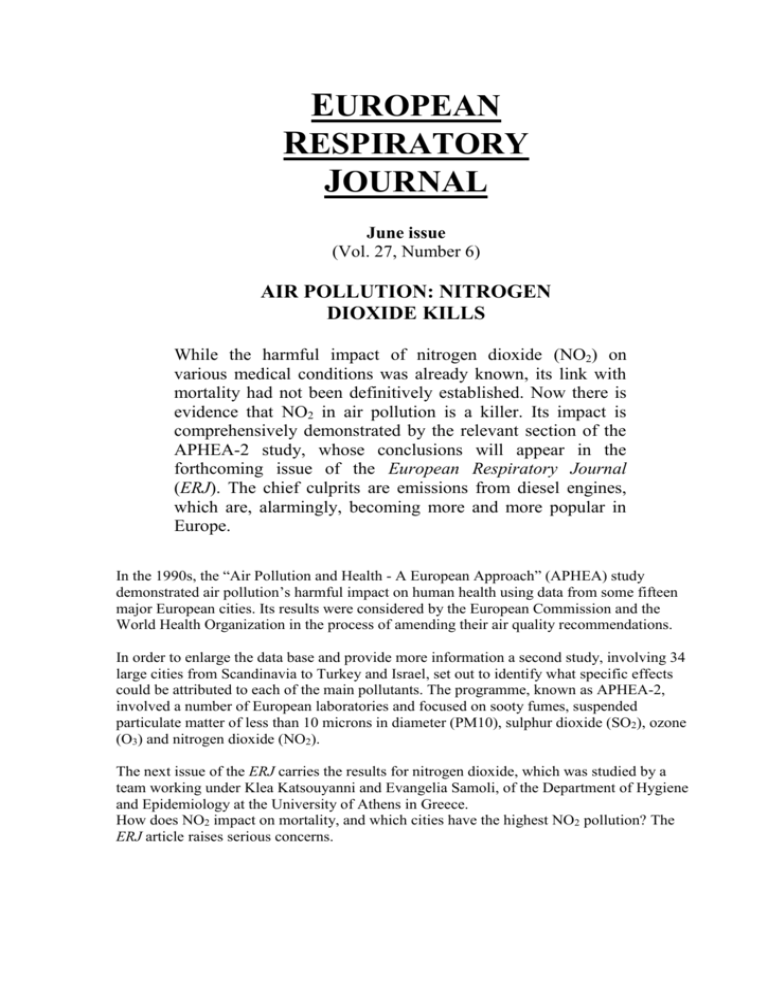
EUROPEAN RESPIRATORY JOURNAL June issue (Vol. 27, Number 6) AIR POLLUTION: NITROGEN DIOXIDE KILLS While the harmful impact of nitrogen dioxide (NO2) on various medical conditions was already known, its link with mortality had not been definitively established. Now there is evidence that NO2 in air pollution is a killer. Its impact is comprehensively demonstrated by the relevant section of the APHEA-2 study, whose conclusions will appear in the forthcoming issue of the European Respiratory Journal (ERJ). The chief culprits are emissions from diesel engines, which are, alarmingly, becoming more and more popular in Europe. In the 1990s, the “Air Pollution and Health - A European Approach” (APHEA) study demonstrated air pollution’s harmful impact on human health using data from some fifteen major European cities. Its results were considered by the European Commission and the World Health Organization in the process of amending their air quality recommendations. In order to enlarge the data base and provide more information a second study, involving 34 large cities from Scandinavia to Turkey and Israel, set out to identify what specific effects could be attributed to each of the main pollutants. The programme, known as APHEA-2, involved a number of European laboratories and focused on sooty fumes, suspended particulate matter of less than 10 microns in diameter (PM10), sulphur dioxide (SO2), ozone (O3) and nitrogen dioxide (NO2). The next issue of the ERJ carries the results for nitrogen dioxide, which was studied by a team working under Klea Katsouyanni and Evangelia Samoli, of the Department of Hygiene and Epidemiology at the University of Athens in Greece. How does NO2 impact on mortality, and which cities have the highest NO2 pollution? The ERJ article raises serious concerns. Direct effect on mortality The team drew on the largest existing European database, which covers over 60 million people, with pollution measurements for at least three consecutive years. Mortality and hospital admissions data were compared with measurements for various atmospheric pollutants taken by the ambient air monitoring stations in each of the APHEA-2 cities. The comparison produced some alarming results, showing that short-term mortality rates (i.e. in the days directly following the exposure to the pollutant) are very clearly linked to daily variations in the level of NO2, essentially an urban pollutant mainly produced by diesel engines and heating systems. A rise in atmospheric nitrogen dioxide levels of ten microgrammes per cubic metre (10 µg/m3) was found to increase short-term mortality by 0.30%. The statistical link retained its significance even when various confounding factors, such as the effect of other pollutants or a flu epidemic, were taken into account. Heart and lungs under attack As the ERJ article reports, the correlation with NO2 concentrations is clearer still if we focus specifically on deaths from cardiovascular and respiratory causes in the days directly following exposure. Indeed, a rise of 10 µg/m3 in NO2 levels increases deaths from cardiovascular and respiratory conditions by 0.40% and 0.38%, respectively. The impact also varies according to length of exposure. Comparison of the levels measured over six days (the date of death and the preceding five days) with those measured over two days (the date of death and the previous day) shows that 22% more cardiovascular deaths and 45% more respiratory deaths were connected with the six-day exposure. “This most likely reflects different physiopathological effects”, state the authors. “NO2’s cardiovascular effects are generally associated with mortality in the short-term (sudden deaths without hospitalisation), while its respiratory effects tend to involve disease that will cause death at a later date”, Katsouyanni explains. Less impact from NO2 in the East Another important finding revealed in June’s ERJ article is that, while NO2 unarguably affects mortality, its impact varies widely in different cities. Greater impact can be seen in the cities of north-western and southern Europe than in their central and eastern European counterparts. “In the 1990s, atmospheric pollution in southern and western European cities was caused mainly by road traffic, while eastern Europe had fewer cars at the time”, the team explains. “Since road traffic generates more toxic air pollution, this could be the reason for the difference”. Another possible explanation is the lower life expectancy in eastern Europe: as the APHEA-2 study confirms, older people are worse affected by pollution. Indeed, there is greater mortality from respiratory causes in cities with a higher proportion of elderly inhabitants. “Older people seem more vulnerable to the short-term effects of air pollution", Katsouyanni believes, "probably because most of them already have respiratory conditions or other diseases that make them more sensitive”. Diesel takes its toll The APHEA-2 study also shows that the effects of NO2 and PM10 can interact. Nitrogen dioxide seems to have a stronger impact when combined with high levels of suspended particulate matter. Both of these pollutants are mainly emitted by diesel engines. We need to improve monitoring of diesel fuel quality and diesel vehicle maintenance, according to Katsouyanni. “We also need to cut back on using these vehicles, since they emit 40% more particulate matter, even when monitoring and quality are optimal”, she adds. Unfortunately, the situation on the ground is the exact opposite, with steady rises in the number of diesel-powered vehicles throughout Europe. So the situation is worrying, though not yet catastrophic. The APHEA-2 data show that urban NO2 levels do not yet exceed the limits adopted by the European Union, which were established on the basis of the results from APHEA-1 and other studies. But those limits are now being reviewed on the basis of new data from further studies. No doubt APHEA-2 will be taken into consideration for future standards. Title of the original article: Short-term effects of nitrogen dioxide on mortality: an analysis within the APHEA project
